#vespilloides
Text
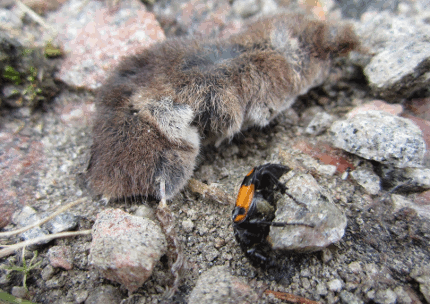
#nicrophorus#vespilloides#silphidae#insecta#hexapoda#arthropoda#animaila#sorex araneus#soricidae#soricomorpha#mammaila#vertebrata#death#gif#exercising
0 notes
Text
The raddest lil' insectfriends I've made during 2022. Not sure if it's controversial to pick bugs up but I usually do it just because they need to be moved to a safer place. The first corpse-loving fella was sadly injured.
1# Licrophorus vespilloides, 2# some kind of Asilidae, 3# Acronicta alni, 4# Aanorpa communis, 5# Leucodonta albida, 6# Anoplotrupes stercorosus, 7# Limax cinereoniger, 8# Ctenicera pectinicornis, 9# Cimbex connatus, 10# Deilephila elpenor
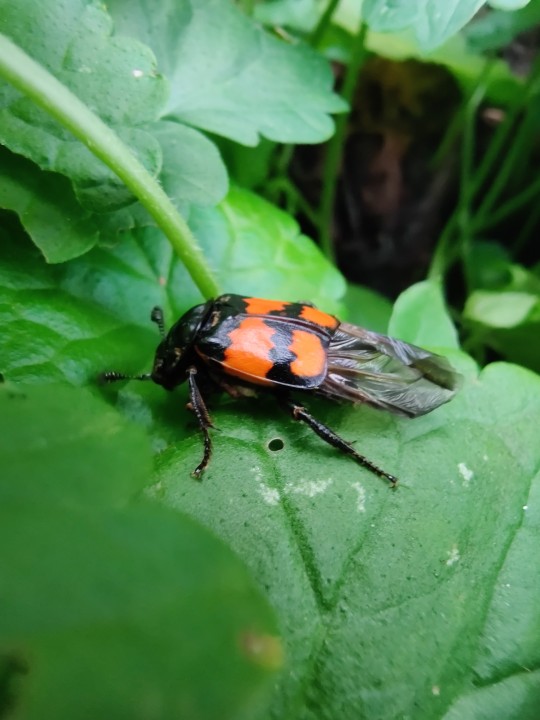
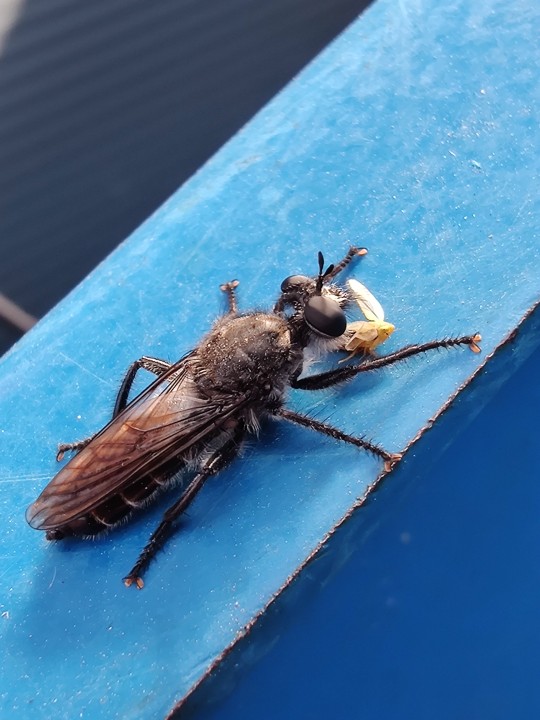








2 notes
·
View notes
Photo
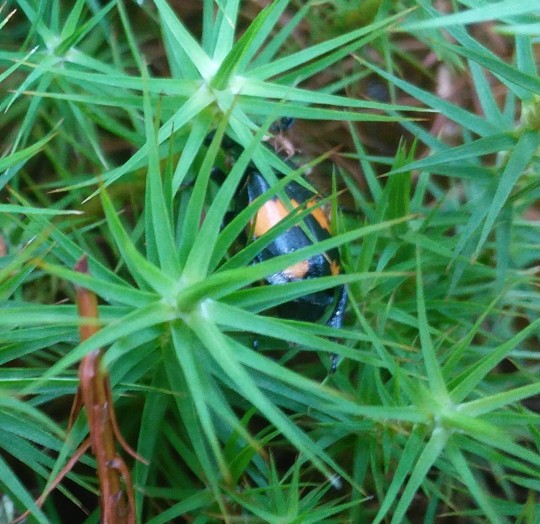
Startled a Burying Beetle (Nicrophorus vespilloides) that had been chilling under a bit of dead pheasant.
Not the greatest of pics, cos I wasn’t expecting the beetle and it sure wasn’t expecting me. It disappeared into the moss here fairly quickly.
The pic shows the beetle, sorta, along with a couple of little brown phoretic mites clinging to it. They have a mutual relationship where the mites travel with the beetle, and eat fly eggs and larva on whatever carrion they find, so there is less competition for food for the beetle larva.
Wish I had been able to get a better pic of it before it scurried deep into the moss, but I’m not gonna tear up a bed of moss to find it. It’s pretty unusual habitat around here, so it should be preserved if possible.
6 notes
·
View notes
Text
Phoresy: mites hitchhiking on burying beetles
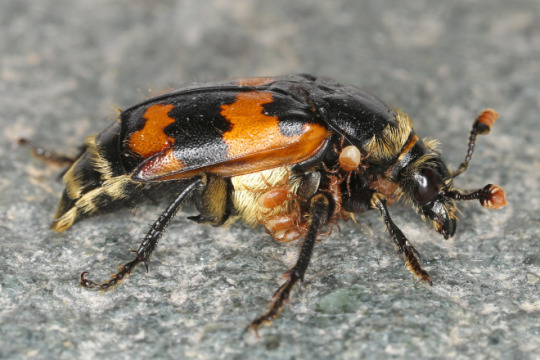
Nicrophorus vespillo Linnaeus, 1758, infested with Poecilichirus mites, Denmark (Donald Hobern, Flickr CC)
Phoresy, which is also called phoresis, is an association between two organisms, where one travels on the body of another, without being a parasite or causing it any harm. In this case, the hitchhiker is a mite, which attaches itself to a beetle, solely for the purpose of travel (above). The…
View On WordPress
#Burying beetles#Common Sexton Beetle#Nicrophorus spp.#Nicrophorus vespilloides#phoresis#phoresy#Poecilochirus#Poecilochirus carabi#Poecilochirus mite#Sexton beetles
4 notes
·
View notes
Photo
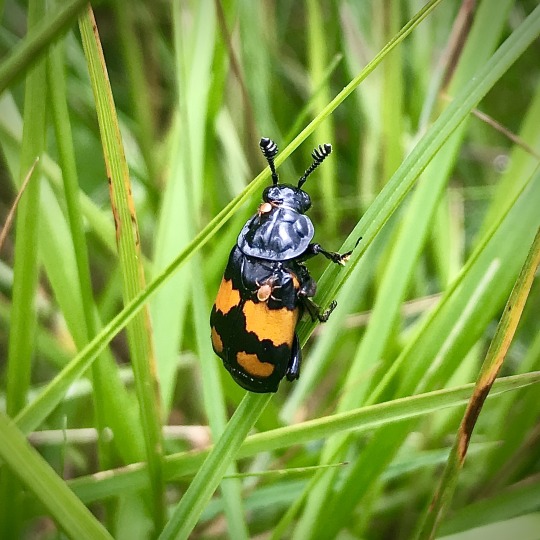
Common Sexton Beetle (Nicrophorus vespilloides). ‘The undertakers of the animal world.’ A sexton is a person who looks after a churchyard, typically a gravedigger. These beetles have a similar role interring the dead. They’re known as a ‘burying beetles’ because after they have found a dead animal, such as a small bird or rodent, they bury the corpse, lay their eggs on it, and then continue to feed their larvae on the decaying flesh after they’ve hatched. You can see in this photograph two red spider mites attached to the beetle’s back. This is a common site on Sexton Beetles. The mites have the same lifespan as the beetle and often spend their entire lives together. Glenfeshie Estate, Cairngorms, July 2020. SP
0 notes
Text
How beetle larvae thrive on carrion
The burying beetle Nicrophorus vespilloides buries the cadavers of small animals to use them as a food source for its offspring. However, the carcass is susceptible to microbial decomposition. Researchers show that the beetles replace harmful microorganisms with their own beneficial gut symbionts, thus turning a carcass into a nursery with a microbial community that even promotes larval growth.
from Nature's Incredible! https://ift.tt/2AbJs1r via Nature & Insects
0 notes
Text
How beetle larvae thrive on carrion
The burying beetle Nicrophorus vespilloides buries the cadavers of small animals to use them as a food source for its offspring. However, the carcass is susceptible to microbial decomposition. Researchers show that the beetles replace harmful microorganisms with their own beneficial gut symbionts, thus turning a carcass into a nursery with a microbial community that even promotes larval growth.
from Bacteria News -- ScienceDaily https://ift.tt/2AbJs1r via mold removal Boca Raton
mold removal Boca Raton
from Blogger https://ift.tt/2EpbVF3
October 15, 2018 at 03:56PM
0 notes
Photo
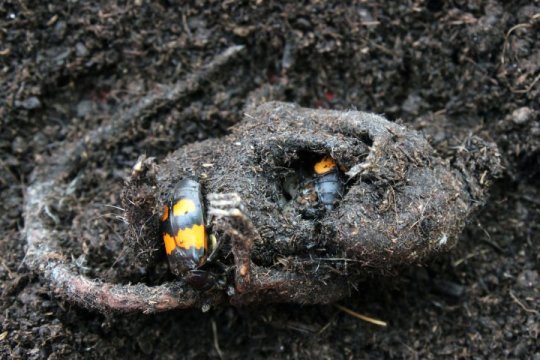
How beetle larvae thrive on carrion The burying beetle Nicrophorus vespilloides buries the cadavers of small animals to use them as a food source for its offspring.
#beetle#carrion#larvae#Quantum Physics; Albert Einstein; Optics; Physics; Tsunamis; Natural Disasters; Weather; Wildfires#thrive
0 notes
Text
How beetle larvae thrive on carrion
The burying beetle Nicrophorus vespilloides buries the cadavers of small animals to use them as a food source for its offspring. However, the carcass is susceptible to microbial decomposition. Researchers show that the beetles replace harmful microorganisms with their own beneficial gut symbionts, thus turning a carcass into a nursery with a microbial community that even promotes larval growth.
Latest Science News -- ScienceDaily https://www.sciencedaily.com/releases/2018/10/181015150646.htm
0 notes
Text

#nicrophorus vespilloides#silphidae#coleoptera#insecta#hexapoda#arthropoda#animaila#sorex araneus#soricidae#soricomorpha#mammaila#vertebrata#chordata#death#gif#burying
0 notes
Photo
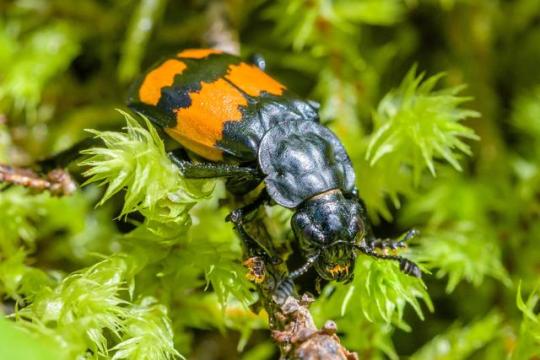
Sexton beetle (Nicrophorus vespilloides) [2560x1707] [OC]
0 notes
Video
This pretty beetle is being attacked by red mites. Going to try to get them off of him so he can go about his business. If he unfortunately dies, ill put him in resin but definitely going to try to save him first. These guys are known for carying the #Poecilochirus #carabi mites, but this guy looks like he's being killed by these since there are so many. The beetle species is #Nicrophorus #vespilloides.
1 note
·
View note
Text
Decomposition of a mole
Decomposition of a mole

Common flesh flies (Sarcophaga carnaria) on mole carcass.
I came across a dead mole as I was walking along a logging tract in a pine forest in Galicia, northern Spain. It looked as though it had only just died, as the first wave of colonisation – by blow flies (Diptera: Calliphoridae) – was only just in progress.
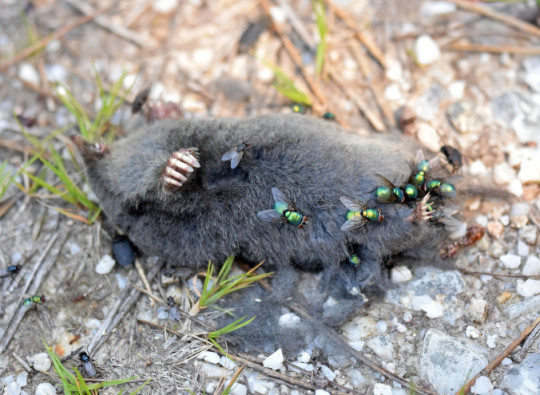
Dead mole with green bottle flies.
Green bottle flies (probably Lucilia sericata)…
View On WordPress
#Burying beetles#Common flesh flies#Galicia#Green bottle flies#Nicrophorus vespilloides#Oiceoptoma thoracica#Poecilochirus carabi#Sarcophaga carnaria#Sexton beetles#Spain#symbiosis
0 notes